《国际会计学》课程教学大纲
国际会计准则课程教学大纲

《国际会计准则》课程教学大纲一、课程性质国际会计准则是会计专业硕士学位学生的一门专业选修课。
开课学期在第二学期。
先修课程有高级财务会计专题、税务会计专题等课程。
二、教学目的使学生了解国际范围内会计准则的基本模式和内容,通过本门课程的学习,进一步了解国际会计准则变迁的背景和过程,了解国际范围内会计准则的主要模式和主要差异,对比国际准则与我国会计准则概念框架、具体准则的差异相同点。
三、教学要求根据教学内容、学生特点及学时安排,采取课堂授课、案例分析、分组讨论等相结合方式组织教学,要求学生阅读大量的相关资料,完成相关的学习、讨论等教学环节,培养学生的独立研读能力。
四、教学内容及学时分配课程内容与学时分配五、授课方式、课程考核及成绩评定授课方式采用学生参与方式教学方式。
要求对具体准则部分分小组讨论、小组课堂讲解,其他学生和老师提问方式构成。
考核方式为课程论文平时成绩占总成绩比例为30%,期末考试占70%。
平时成绩的构成:课堂小组讨论占平时成绩50%,平时作业占50%。
六、推荐教材和教学参考书七、教学具体内容和要求第一章引言一、基本要求了解国际会计准则的发展基本内容和发展情况。
二、授课方法教师讲授和学生自学相结合。
三、教学内容(一)国际会计准则的界定1.广义国际会计准则2.狭义的国际会计准则(二)课程安排和教学过程设计(三)国际会计准则的内容和变迁过程1.国际会计准则的产生2.国际会计准则的变迁(四)正在进行的全面修订四、重点难点1.国际会计准则改组的原因;2.国际会计准则的变迁过程。
五、思考与讨论1.国际会计准则与美国会计准则是如何握手言和的?2.你如何理解我国的国际协调化?3.你如何看待协调化和差异化问题?第二章国际会计准则的发展与变迁一、基本要求了解国际会计准则中国际准则、美国会计准则、中国会计准则的发展基本内容和发展情况。
二、授课方法三、教学内容(一)国际会计准则的变迁过程1.国际会计准则的产生2.国际会计准则的变迁3.国际会计准则变迁的特点(二)美国会计准则的变迁过程1.美国会计准则的产生2.美国会计准则的变迁3.美国会计准则变迁的特点(三)中国会计准则的变迁过程1.中国会计准则的产生2.中国会计准则的变迁3.中国会计准则变迁的特点四、重点难点1.国际会计准则变迁的特点和动因;2.美国会计准则的变迁特点和动因;3. 国际会计准则变迁的特点和动因;4.目标导向、原则导向、规则导向差异和特点;五、思考与讨论1.国际会计准则如何演变为国际会计发展中霸主地位的?2.国际会计准则的模式是什么?3.美国会计准则的主导模式是什么?4.美国产生财务丑闻与会计准则导向选择之间关系如何?5.你认为我国应当采用何种准则导向?为什么?第三章国际会计概念框架及比较一、基本要求了解国际会计准则中国际准则、美国会计准则、中国会计准则的概念框架的基本内容和差异。
会计学原理教学大纲
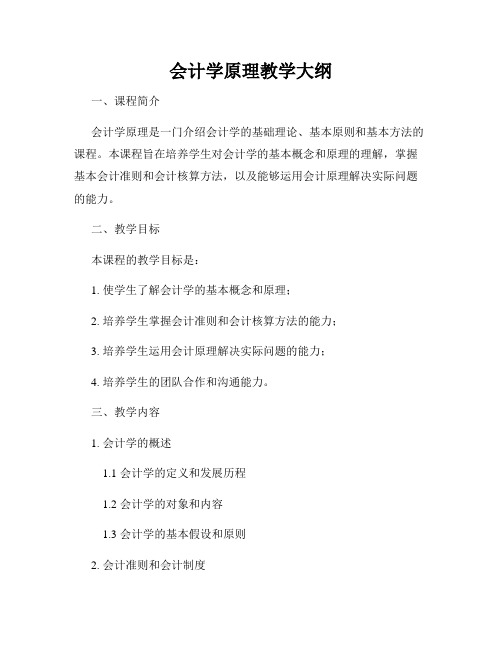
会计学原理教学大纲一、课程简介会计学原理是一门介绍会计学的基础理论、基本原则和基本方法的课程。
本课程旨在培养学生对会计学的基本概念和原理的理解,掌握基本会计准则和会计核算方法,以及能够运用会计原理解决实际问题的能力。
二、教学目标本课程的教学目标是:1. 使学生了解会计学的基本概念和原理;2. 培养学生掌握会计准则和会计核算方法的能力;3. 培养学生运用会计原理解决实际问题的能力;4. 培养学生的团队合作和沟通能力。
三、教学内容1. 会计学的概述1.1 会计学的定义和发展历程1.2 会计学的对象和内容1.3 会计学的基本假设和原则2. 会计准则和会计制度2.1 会计准则的概念和分类2.2 国内外常用的会计准则体系2.3 会计信息的质量特征和会计伦理3. 会计核算基本原理与方法3.1 会计要素和会计等式3.2 会计账户和核算方法3.3 基本会计核算报表的编制方法4. 资产负债表和利润表的分析4.1 资产负债表的结构和要素分析4.2 利润表的结构和要素分析4.3 资产负债表和利润表的横纵向分析方法5. 现金流量表的编制和分析5.1 现金流量表的用途和编制方法5.2 现金流量表的分析方法和应用6. 会计估计和会计错误的纠正6.1 会计估计的基本概念和方法6.2 会计错误的发现和纠正方法7. 会计信息系统与内部控制7.1 会计信息系统的组成和功能7.2 内部控制的基本原理和要素7.3 内部控制的评价和改进四、教学方法1. 讲授法:通过讲解会计学原理的理论知识,帮助学生理解基本概念和原则。
2. 实例分析法:通过实际案例的分析,培养学生应用会计原理解决实际问题的能力。
3. 讨论与互动:开展课堂讨论和小组互动,促进学生的团队合作和沟通能力的培养。
4. 作业与案例:布置相关作业和案例分析,帮助学生巩固理论知识并提高实际应用能力。
五、考核方式1. 平时表现:包括课堂参与情况、作业完成情况等。
2. 期中考试:对学生对会计学原理的理论知识掌握情况进行评估。
mpacc教学大纲
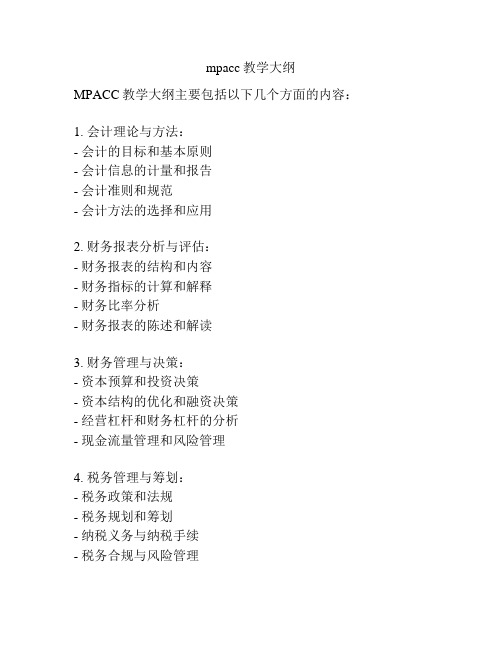
mpacc教学大纲
MPACC教学大纲主要包括以下几个方面的内容:
1. 会计理论与方法:
- 会计的目标和基本原则
- 会计信息的计量和报告
- 会计准则和规范
- 会计方法的选择和应用
2. 财务报表分析与评估:
- 财务报表的结构和内容
- 财务指标的计算和解释
- 财务比率分析
- 财务报表的陈述和解读
3. 财务管理与决策:
- 资本预算和投资决策
- 资本结构的优化和融资决策
- 经营杠杆和财务杠杆的分析
- 现金流量管理和风险管理
4. 税务管理与筹划:
- 税务政策和法规
- 税务规划和筹划
- 纳税义务与纳税手续
- 税务合规与风险管理
5. 内部控制与审计:
- 企业内部控制体系的建立和运行
- 内部审计的方法和程序
- 外部审计师的角色和职责
- 企业风险管理和合规性审计
6. 管理会计与绩效管理:
- 费用与效益分析
- 成本管理和控制
- 绩效评价和激励机制
- 管理会计信息系统的设计与应用
7. 国际会计与金融:
- 国际会计准则和会计理论的发展趋势
- 国际金融市场与金融工具
- 国际投资和跨国公司的财务管理
- 国际税务和利润转移定价
以上是MPACC教学大纲的主要内容,具体的课程设置和教学方法还需根据教学机构的实际情况进行调整和补充。
会计信息系统(双语)-教学大纲

《会计信息系统(双语)》教学大纲课程编号:041124B课程类型:□通识教育必修课□通识教育选修课□专业必修课 专业选修课□学科基础课总学时:64讲课学时:32实验(上机)学时:32学分:4适用对象:国际会计学(CGA)先修课程:包括会计学、财务管理学在内的专业基础课和专业课;管理信息系统;数据库及其应用。
一、教学目标(Course Objects)本课程重点学习会计信息系统的基本原理、会计信息系统的结构与功能,典型会计信息系统的使用与操作等,培养学生使用会计信息系统的实践能力,为将来同学从事会计实务打下扎实基础。
具体来讲,本课程教学目标包括:目标1:理解会计信息系统的原理、结构以及功能(To understand the basic principles, structures and functions of accounting information systems);目标2:理解销售收款循环、采购付款循环和生产成本循环的基本概念以及运行机制(To understand the basic concepts and operational mechanism of the revenue, expenditure and conversion cycles);目标3:理解财务报告系统和管理报告系统的原理(To understand theprinciples of financial reporting and management reporting systems);目标4:理解会计信息系统的内部控制(To understand the internal control of accounting information systems);目标5:理解如何管理系统开发生命周期(To understand how to manage the systems development life cycle);目标6:通过实验教学熟悉一个实际系统的结构与功能,学会使用该系统解决实际问题(To familiar with what is the structures and functions of a real AIS through experimental studies and know to apply the real AIS to solve the problems in practice)。
《基础会计》课程教学大纲.doc
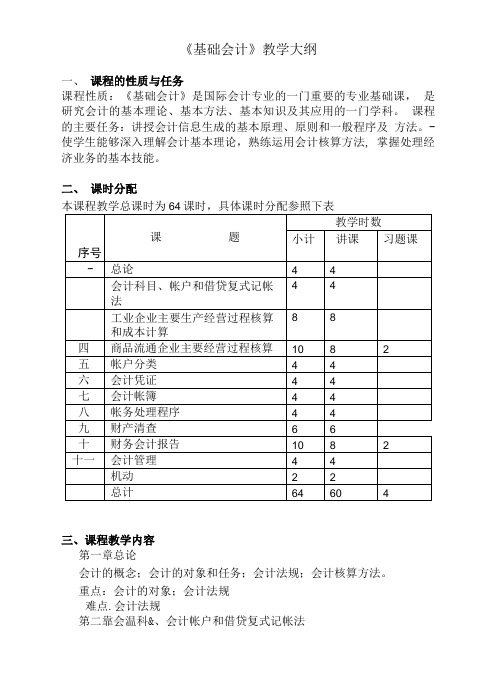
《基础会计》教学大纲一、课程的性质与任务课程性质:《基础会计》是国际会计专业的一门重要的专业基础课,是研究会计的基本理论、基本方法、基本知识及其应用的一门学科。
课程的主要任务:讲授会计信息生成的基本原理、原则和一般程序及方法。
-使学生能够深入理解会计基本理论,熟练运用会计核算方法, 掌握处理经济业务的基本技能。
二、课时分配本课程教学总课时为64课时,具体课时分配参照下表序号课题教学时数小计讲课习题课- 总论44会计科目、帐户和借贷复式记帐法44工业企业主要生产经营过程核算和成本计算88四商品流通企业主要经营过程核算1082五帐户分类44六会计凭证44七会计帐簿44八帐务处理程序44九财产清查66十财务会计报告1082十一会计管理44机动22总计64604三、课程教学内容第一章总论会计的概念;会计的对象和任务;会计法规;会计核算方法。
重点:会计的对象;会计法规难点.会计法规第二靠会温科&、会计帐户和借贷复式记帐法会计科目;会计帐户;借贷复式记帐法。
14重点:借贷复式记帐法 难点:会计分录的编制第三章工业企业主要生产经营过程核算和成本计算主要经营过程核算和成本计算的意义和内容;资金筹集的核算; 供应过程的核算;生产过程核算;销售过程及利润和利润分配的 核算;资金调整和退出的核算。
重点:生产过程核算;销售、利润及利润分配的核算 难点:利润及利润分配的核算第四章商品流通企业主要经营过程核算商品流通企业主要经营过程核算概述;商品流通企业核算需要设 置的帐户;批发商品的核算;零售商品的核算;商品流通费用的 核算;利润和利润分配的核算。
重点:批发商品的核算;零售商品的核算。
难点:零售商品的核算 第五章帐户分类概述;基本帐户;调整帐户;业务帐户。
重点:基本帐户;调整帐户;业务帐户。
难点:调整帐户 第六章会计凭证会计食品的睿义和种类;原始凭证的填制与审核;记帐凭证的填 制与审核;会计凭证的传递与保管。
国际会计(双语)国际会计(双语)大纲
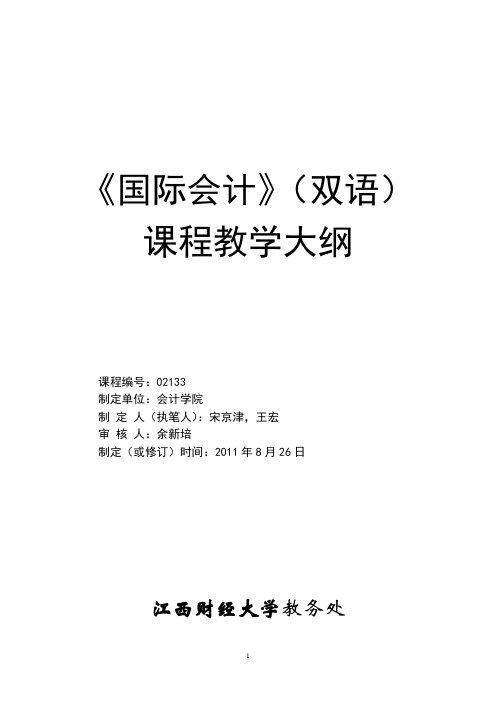
《国际会计》(双语)课程教学大纲课程编号:02133制定单位:会计学院制定人(执笔人):宋京津,王宏*******制定(或修订)时间:2011年8月26日江西财经大学教务处《国际会计》(双语)课程教学大纲一、课程总述本课程大纲是以2011年国际会计(双语)本科专业人才培养方案为依据编制的。
二、教学时数分配三、单元教学目的、教学重难点和内容设置Study guide for international accountingCHAPTER 1Introduction to international accountingLEARNING OBJECTIVES:1.To identify and understand the importance of the eight factors that has asignificant influence on accounting development.2.To understand the definition of IA of this textbook.3.To be familiar with the detailed contents of IACHAPTER OUTLINEDevelopment of IAEight factors▪Sources of Finance–In countries with strong equity markets, Disclosures are extensive to meet the requirements of widespread public ownership.–in credit-based systems where bans are the dominant source of finance, accounting focuses on creditor protection through conservative accounting measurements. Development of IA▪Legal System. The legal system determines how individuals and institutions interact.▪Taxation . tax legislation effectively determines accounting standards because companies must record revenues and expenses in their accounts to claim them for tax purposes.▪Political and Economic Ties. Accounting ideas and technologies are transferred through conquest, commerce, and similar forces.Development of IA▪Inflation. Inflation distorts historical cost accounting and affects the tendency of a country to incorporate price changes into the accounts.▪Level of Economic Development. This factor affects the types of business transactions conducted in an economy and determines which ones are most prevalent.Development of IA▪Education Level. Highly sophisticated accounting standards and practices are useless if they are misunderstood and misused.▪Culture. Cultural variables underlie nations’ institutional arrangements (such as legal systems)Definition of IAInternational accounting can be viewed in terms of the accounting issues uniquely confronted by companies involved in international business. It also can be viewed more broadly as the study of how accounting is practiced in each and every country around the world, learning about and comparing the differences in financial reporting and other accounting practices that exist across countries.Definition of IAThis book is designed to be used in a course that attempts to provide an overview of the broadly defined area of international accounting, and that focuses on the International Financial Reporting Standards (IFRSs) issued by International Accounting Standards Board (IASB) and some international hot topics.Detailed Contents on IA▪International accounting is a well-established specialty area within accounting and has two major dimensions:▪Comparative: Examining how and why accounting principles differ from country to country▪Pragmatic: accounting for the operational problems and issues encountered by individuals and firms in international business.Detailed Contents on IA▪L. Radebaugh and S. Gray (1993, p. 9) also write that the study of international accounting involves two major areas:▪descriptive/comparative accounting and the accounting dimensions of international transactions/multinational enterprises.▪principally covers the problems encountered by multinational corporations: Financial reporting problems, translation of foreign currency financial statements, information systems, budgets and performance evaluation, audits, and taxes.Objectives of Research on IA▪Global Harmonization. As business entities increasingly operate in multiple counties, they encounter the cost of dealing with diversity in financial reporting requirements.▪Financial Reporting in Emerging Economics. As ever increasing amounts of capital are invested in countries with emerging economics, the quality of financial reporting in these countries is coming under the microscope. Objectives of Research on IA▪Social and Environmental Reporting. One of the consequences of the globalization of business enterprises is that companies now have stakeholders not just in their home country but in all the countries where they operate.CHAPTER 2International accounting harmonizationLEARNING OBJECTIVES:1. Recognize the arguments for and against harmonization.2. Identify the pressures for and the obstacles to harmonization.3. Become familiar with the main organizations involved in harmonization. CHAPTER OUTLINEHistory and Recent Developments▪Prior to 1960, there was little effort devoted to the international harmonization of accounting standards. Efforts have been made by a number of organizations to reduce the differences between accounting systems since then.Main International Bodies InvolvedPrinciples-Based vs. Rules-Based Approaches▪Principles-based standards represent the best approach for guiding financial reporting and standard setting, of any given transaction.▪Rules-based standards provide companies the opportunity to structure transactions to meet the requirements for particular accounting treatments.Obstacles to Harmonization▪Differences in the regulatory framework .▪The "true and fair view" .▪The various interpretation of fundamental principle .▪ A binding tax accounting linkLikely future trends▪The convergence of IAS and national accounting standards is, and always has been one of the IASB's key objectives. Three basic future roles exist for the IASB:✓Producing standards for those countries that have no standards of their own✓Assisting in the reduction of diverse national practices✓Acting as an umbrella organizing for national standard settersImplication▪The demand of international capital markets helps to drive harmonization. IASB has become more cognizant of the need to work with national standard setters and bring them into membership of IASB, which may be possible to eliminate the differences between national and international standards. The current agreement could then be viewed as the first step in a much longer process.IASB ( International Accounting Standards Board)▪IASB's responsibilities:✓Develop and issue International Financial Reporting Standards and Exposure Drafts, and✓Approve Interpretations developed by the International Financial Reporting Interpretations Committee (IFRIC).CHAPTER 3ACCOUNTING FOR FOREIGN CURRENCYLEARNING OBJECTIVES:▪ 1. Provide an overview of foreign exchange markets and define related terminology.▪ 2. Describe the different types of foreign exchange exposure and exchange difference.▪ 3. Understand some of the more common foreign currency transactions. CHAPTER OUTLINEAccounting for Foreign Currency Transactions▪ a transaction that requires payment or receipt (settlement) in a foreign currency is called a foreign currency transaction.▪Exchange difference is the difference resulting from reporting the same number of units of a foreign currency in the reporting currency at different exchange rates. Accounting for Foreign Currency Transactions▪Importing or Exporting of Goods or Services✓At the date the transaction is first recognized.✓At each balance sheet date that occurs between the transaction date and the settlement date.✓At the settlement date.Accounting for Foreign Currency Transactions▪Recognition of Exchange Differences✓the single- transaction approach✓the two- transaction approachHedging Foreign Exchange Rate Risk▪A derivative instrument may be defined as a financial instrument that by its terms at inception or upon occurrence of a specified event, provides the holder (or writer) with the right (or obligation) to participate in some or all of the price changes of another underlying value of measure, but does not require the holder to own or deliver the underlying value of measure.Hedging Foreign Exchange Rate Risk▪two broad categories✓Forward-based derivatives, such as forwards, futures, and swaps, in which either party can potentially have a favorable or unfavorable outcome, but not both simultaneously (e.g., both will not simultaneously have favorable outcomes).✓Option-based derivatives, such as interest rate caps, option contracts, and interest rate floors, in which only one party can potentially have a favorable outcome and itagrees to a premium at inception for this potentiality; the other party is paid the premium, and can potentially have only an unfavorable outcome.Hedging Foreign Exchange Rate Risk▪Forward Exchange Contracts▪Options▪Fair Value Hedge – Using a Forward Contract▪Hedging an Identifiable Foreign Currency Commitment Using a Forward Contract (A Fair Value Hedge)▪Hedging a Forecasted Transaction Using an Option (Cash Flow Hedge) Translation Of Foreign Financial Statements▪Derivation of the Issue of Foreign Currency Translation✓Translation exposure, sometimes also called accounting exposure, refers to gains or losses caused by the translation of foreign currency assets and liabilities into the currency of the parent company for accounting purposes.✓The choice of any method for the translation of the financial statements of a foreign business operation involves two basic questions:(i) how shall foreign currency financial statements be translated——in particular what exchange rates are to be used for different assets/liabilities/equity accounts?(ii) how and when shall foreign exchange gains or losses be recognized?CHAPTER 4Business combinationsLEARNING OBJECTIVES:•(1)Understand the economic motivations underlying business combinations.•(2)Learn about the alternative forms of business combinations, from both the legal and accounting perspectives.•(3)Introduce concepts of accounting for business combinations;•(4)emphasizing the purchase method.•(5)See how firms make cost allocatCHAPTER OUTLINE➢ 4.1 The Accounting Concept of Business Combinations➢ 4.2 The Legal Form of Business Combinations➢ 4.3 Reasons for Business Combinations➢ 4.4 Accounting for Business Combinations Under the Purchase Method ➢ 4.5 The measurement of Goodwill and ControversyCHAPTER 5Consolidated financial statementsLEARNING OBJECTIVES:•(1)Recognize the benefits and limitations of consolidated financial statements.•(2)Understand the requirements for inclusion of a subsidiary in consolidated financial statements.•(3)Apply the consolidation concepts to parent company recording of the investment in a subsidiary at the date of acquisition.•(4)Allocate the excess of the fair value over the book value of the subsidiary at the date of acquisition.CHAPTER OUTLINE➢ 5.1 Demand from IAS 27➢ 5.2 The adjustment of Intercompany Transactions➢ 5.3 Parent Company Recording and Consolidated Statement of financial position at Acquisition Date➢ 5.4 Subsequent Statement of financial positionCHAPTER 6Accounting for changing priceLEARNING OBJECTIVES:▪ 1. Explain basic concepts relating to inflation accounting. Understand the distinction between changes in the general level of prices in an economy, which affect the purchasing power of the measuring unit, and changes in the prices of specific assets and liabilities, which affect balance sheet valuations and income measurement.▪ 2. Explain the underlying thoughts and methods of dealing with inflation.▪ 3. Restate conventional financial statements based on historical costs to a common measuring unit.CHAPTER OUTLINEDefects of historical cost accounting▪The results of comparison of performance and position statements over time will be unreliable, because amounts are not valued in terms of common units.▪Borrowings are shown in monetary terms, but in a time of rising prices a gain is actually made (or a loss in times of falling prices) at the expense of the lender as, in real terms, the value of the loan has decreased or increased.▪Conversely, gains arising from holding assets are not recognized.▪Depreciation writes off the historical cost over time, but, where asset values are low (because based on outdated historical costs), depreciation will becorrespondingly lower, so that a realistic charge for asset consumption is not matched against revenue in the performance statements.Overview of Accounting for changing prices▪Changing prices affect financial reports in two principal ways:✓Measuring unit problem✓Valuation problemAccounting Measurement Alternatives▪Acquisition Cost/Nominal Dollar Accounting▪Acquisition Cost/Constant Dollar Accounting▪Current Cost/Nominal Dollar Accounting▪Current Cost/Constant Dollar AccountingRestatement of Monetary and Non-monetary Items▪ A monetary item is a claim receivable or payment in a specified number of dollars, regardless of changes in the purchasing power of the dollar.▪ A non-monetary item is any asset, liability, or shareholders’ e quity account that has no claim to or for a specified number of dollars.Evaluation of Acquisition Cost/Constant Dollar Accounting▪When compared with current-cost accounting (discussed next), constant-dollar accounting carries a higher level of objectivity. Independent accountants can examine canceled checks, invoices, and other documents to verify acquisition-cost valuations and transaction dates. The restatements to constant dollars use general price indexes published by governmental bodies. Evaluation of Current Cost/Nominal Dollar Accounting▪Current-cost accounting measures performance and financial position in terms of the current market prices. Managers likely make decisions in terms of current costs, not out-of-date acquisition costs. Thus, for asses sing management’s actions, current-cost financial statements provide information on the same basis that management used to make decisions.▪Critics note two shortcomings of current cost/nominal dollar accounting:✓auditors cannot as easily verify current-replacement-cost valuations as they can acquisition-cost valuations.✓the use of nominal dollars means that the measuring unit underlying current-replacement-cost valuations varies across time.CHAPTER 7Accounting for financial instrumentLEARNING OBJECTIVES:1. Examine budgeting and performance evaluation issues for international firms.2. Discuss global risk management tools and strategies including multinational capitalbudgeting and foreign exchange risk management.3. Identify the main constituents of cross-border transfer pricing policies, define thetransfer pricing methods, and consider the issues in devising a transfer pricing strategy.4. Recognize the critical role of information technology systems in the effectiverecording, processing and dissemination of financial and managerial accounting information.CHAPTER OUTLINE1 Challenge for the accounting profession2 Accounting and Reporting for Financial Instruments: International Developments▪In the process of completing the most recent series of amendments, the IASB conducted an extensive due process, which began in 2001 and included the following:▪(1) Conducting numerous board deliberations prior to the June 2002 exposure drafts;2.1 Overview of IAS 32▪The following are the major U.S. standards that address financial instruments accounting and reporting:▪(1) SFAS 107, Disclosures About Fair Value of Financial Instruments.▪(2) SFAS 133, Accounting for Derivative Financial Instruments and Hedging Activities.▪(3) SFAS 140, Accounting for Transfers and Servicing of Financial Assets and Extinguishments of Liabilities.▪(4) SFAS 150, Accounting for Certain Financial Instruments with Characteristics of Both Debt and Equity.2.2 Overview of IAS 392.3 Recognition and Derecognition of Financial Assets and Liabilities2.4 Hedge Accounting Guidance2.5 Impairment of Financial Instruments2.6 Convergence with U.S. GAAP3 Financial instruments3.1 Illustration of Traditional Financial Instrument3.2 Illustration of Derivative Financial Instrument4 DERIV ATIVES USED FOR HEDGING▪SFAS No. 133 established accounting and reporting standards for derivative financial instruments used in hedging activities. Special accounting is allowed for two types of hedges—fair value and cash flow hedges.4.1 Fair Value Hedge4.2 Illustration of Interest Rate Swap4.3 Cash Flow Hedge5 OTHER REPORTING ISSUES▪Additional issues of importance are as follows:▪(1) The accounting for embedded derivatives.▪(2) Qualifying hedge criteria.▪(3) Disclosures about financial instruments and derivatives.Chapter 8 financial reporting in different countriesLearning objectives:•Identify the major policy-setting bodies and their role in the standard-setting process.•Appreciate US GAAP .•Understand convergence of US GAAP to IFRSs.Chapter outline:Parties Involved in Standard SettingSecurities and Exchange CommissionAmerican Institute of CPAsFinancial Accounting Standards BoardFinancial Accounting Standards BoardDue ProcessTypes of PronouncementsGovernmental Accounting Standards BoardGenerally Accepted Accounting PrinciplesIssues in Financial ReportingIssues in Financial ReportingConceptual FrameworkDevelopment of Conceptual FrameworkChapter 9 corporate governanceLearning objectives:1.describe the definition of corporate governance2.describe some corporate governance theory3.describe the principle of corporate governancechapter outline:2 What is corporate governance?3 Corporate governance theoryPrincipal-agent theoryClassical Stewardship Theory3.3 Modern Stewardship Theory3.4 Stakeholder TheoryPrinciples of corporate governanceCorporate governance modelsMechanisms and controls of corporate governance Features of poor corporate governance。
《国际会计》课程教学大纲
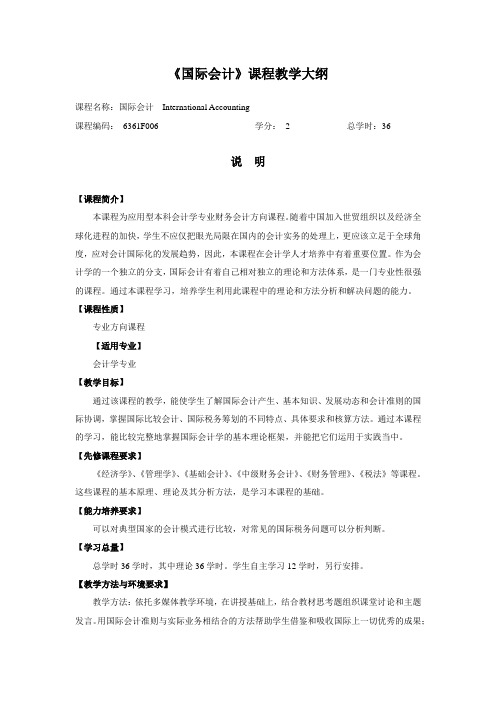
《国际会计》课程教学大纲课程名称:国际会计International Accounting课程编码:6361F006 学分: 2 总学时:36说明【课程简介】本课程为应用型本科会计学专业财务会计方向课程。
随着中国加入世贸组织以及经济全球化进程的加快,学生不应仅把眼光局限在国内的会计实务的处理上,更应该立足于全球角度,应对会计国际化的发展趋势,因此,本课程在会计学人才培养中有着重要位置。
作为会计学的一个独立的分支,国际会计有着自己相对独立的理论和方法体系,是一门专业性很强的课程。
通过本课程学习,培养学生利用此课程中的理论和方法分析和解决问题的能力。
【课程性质】专业方向课程【适用专业】会计学专业【教学目标】通过该课程的教学,能使学生了解国际会计产生、基本知识、发展动态和会计准则的国际协调,掌握国际比较会计、国际税务筹划的不同特点、具体要求和核算方法。
通过本课程的学习,能比较完整地掌握国际会计学的基本理论框架,并能把它们运用于实践当中。
【先修课程要求】《经济学》、《管理学》、《基础会计》、《中级财务会计》、《财务管理》、《税法》等课程。
这些课程的基本原理、理论及其分析方法,是学习本课程的基础。
【能力培养要求】可以对典型国家的会计模式进行比较,对常见的国际税务问题可以分析判断。
【学习总量】总学时36学时,其中理论36学时。
学生自主学习12学时,另行安排。
【教学方法与环境要求】教学方法:依托多媒体教学环境,在讲授基础上,结合教材思考题组织课堂讨论和主题发言。
用国际会计准则与实际业务相结合的方法帮助学生借鉴和吸收国际上一切优秀的成果;联系实际发展我国的会计准则;熟悉和掌握国际通用的商用语言。
环境要求:多媒体教室。
【学时分配】【教材与主要参考书】教材:《国际会计》,常勋;常亮,东北财经大学出版社,2015年1月,第7版参考书:【1】《国际会计前沿》,王松年,上海财经大学出版社,2013年【2】《国际会计学》,徐经长、杜胜利、陈轲,中国人民大学出版社,2015年【3】《国际会计研究》,常勋,中国金融出版社,2015年【4】《国际财务报告准则—阐释与应用》(中国版),本哈德. 裴仁斯等,上海财经大学出版社,2014年【5】《国际会计学》,[美]弗雷德里克·D. S. 乔伊、卡罗尔·安·福罗斯特、加利·K. 米克著,周晓苏、方红星译,东北财经大学出版社,2010年7月【6】《国际会计》,王建新,上海财经大学出版社,2013年5月大纲内容第一章国际会计的形成与发展【教学目的和要求】了解:(1)国际会计师大会的由来与发展(2)早期国际会计定义的区别理解:(1)市场国际化对会计国际化的影响(2)跨国公司兴起对会计国际化的影响(3)会计遗产对会计国际化的影响掌握:(1)国际会计的三大问题(2)会计职业国际化的三个层次(3)各国会计师职业资格考试的差异(4)“世界会计”观的定义(5)“国别会计”观的定义(6)“实务主义”观的定义(7)崔和缪勒的定义(8)伊克彼、麦尔科和伊利马拉夫的定义(9)国际会计的主要内容运用:(1)理论联系实际能够区分会计职业界提供国际性服务的三个层次(2)通过学习各学者的观点,能够评价和比较国际会计的不同定义【内容提要】第一节会计的国际化一、市场的国际化,特别是货币、资本市场的国际化二、跨国公司的兴起和壮大三、会计世袭遗产的国际性四、特定会计方法的国际性质五、会计的国际化与国家化第二节会计职业界的国际化一、会计职业界提供国际性服务的三个层次二、会计职业界的国际组织三、会计职业国际化的阻力第三节国际会计的定义一、国际会计学家在早期对国际会计所下的定义二、20世纪70年代国际会计研究中的三种不同观点三、20世纪80年代至90年代国际会计学家对国际会计所下的定义四、国际会计的主要内容【教学重点与难点问题】教学重点:市场国际化、特别是货币市场和资本市场的国际化,是会计国际化的最主要的推动力量;跨国公司的兴起和壮大对会计国际化的双面影响;国际会计的定义。
mpacc教学大纲
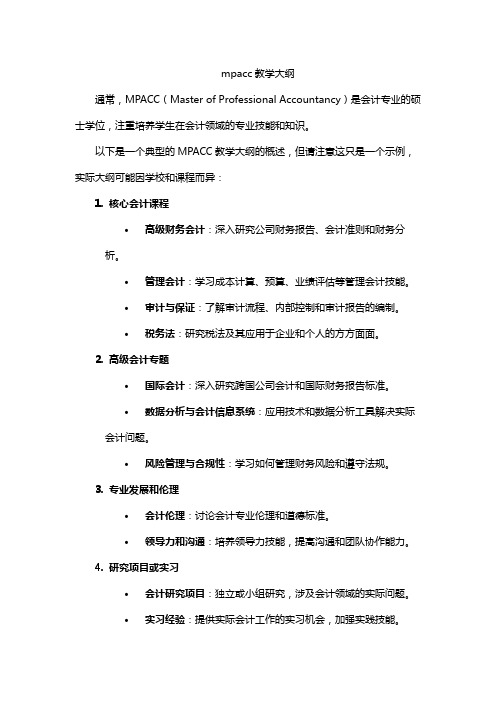
mpacc教学大纲
通常,MPACC(Master of Professional Accountancy)是会计专业的硕士学位,注重培养学生在会计领域的专业技能和知识。
以下是一个典型的MPACC教学大纲的概述,但请注意这只是一个示例,实际大纲可能因学校和课程而异:
1. 核心会计课程
•高级财务会计:深入研究公司财务报告、会计准则和财务分析。
•管理会计:学习成本计算、预算、业绩评估等管理会计技能。
•审计与保证:了解审计流程、内部控制和审计报告的编制。
•税务法:研究税法及其应用于企业和个人的方方面面。
2. 高级会计专题
•国际会计:深入研究跨国公司会计和国际财务报告标准。
•数据分析与会计信息系统:应用技术和数据分析工具解决实际会计问题。
•风险管理与合规性:学习如何管理财务风险和遵守法规。
3. 专业发展和伦理
•会计伦理:讨论会计专业伦理和道德标准。
•领导力和沟通:培养领导力技能,提高沟通和团队协作能力。
4. 研究项目或实习
•会计研究项目:独立或小组研究,涉及会计领域的实际问题。
•实习经验:提供实际会计工作的实习机会,加强实践技能。
5. 毕业论文或终审项目
•毕业论文:对某个特定会计问题进行深入研究和分析。
•终审项目:解决实际公司面临的会计挑战,展示综合应用的能力。
这只是一个例子,具体的MPACC大纲将取决于学校的课程设置和教学重点。
如果你对特定学校或课程的MPACC大纲感兴趣,建议直接查阅相关学校或机构的官方网站或联系招生办公室获取最准确和最新的信息。
- 1、下载文档前请自行甄别文档内容的完整性,平台不提供额外的编辑、内容补充、找答案等附加服务。
- 2、"仅部分预览"的文档,不可在线预览部分如存在完整性等问题,可反馈申请退款(可完整预览的文档不适用该条件!)。
- 3、如文档侵犯您的权益,请联系客服反馈,我们会尽快为您处理(人工客服工作时间:9:00-18:30)。
《国际会计》课程教学大纲
一、课程基本信息
课程编号:070075
课程名称:国际会计
学时:48学时
实验学时:0学时
课程类别:专业课
课程性质:必修课
先行课程:基础会计学、中级财务会计、高级财务会计、成本会计、管理会计、财务管理、税法等
适用专业:会计学
责任单位:经济管理系
二、课程性质、目的与任务
《国际会计》是会计学专业的一门必修课。
通过本课程的学习,使学生了解世界各主要国家的会计的理论和实务以及各国会计惯例和差异,拓宽知识面,以适应我国经济与社会改革发展向国际惯例靠拢的需要。
本课程亦是会计专业的前沿类课程。
通过对国际会计课程的讲授,使学生了解在经济全球化快速发展的今天,会计的跨国沟通、交流和协调的重要性。
掌握国际比较会计、国际财务会计、国际管理会计这三大部分的基本理论和基本方法。
本课程在教学内容上着重阐述国际会计的基本理论、基本方法。
主要包括以下几个方面:1、国际比较会计:阐述各主要国家的会计理论和会计实务的基本特征和最新发展;2、国际财务会计:阐述外币会计、物价变动会计、合并会计报表等,侧重介绍基本原理、基本方法和国际会计惯例的结合;3、国际管理会
计:阐述国际转移定价、国际税务筹划、外汇风险管理等内容。
三、课程的内容及要求、教学重点与难点
(一)总论
1、主要教学内容及要求
1)国际会计概念。
(了解)
2)研究国际会计的必要性。
(了解)
3)国际会计的研究领域。
(掌握)
2、知识点与能力点要求
1)知识点:国际会计的研究领域。
2)能力点:深刻领会国际会计概念、研究国际会计的必要性以及国际会计的研究领域。
3、教学的重点与难点
1)教学重点:会计的国际性以及国际会计的研究领域。
2)教学难点:研究国际会计的几大难题。
(二)国际比较会计(上)
1、主要教学内容及要求
1)国际比较会计的研究目的和内容。
(了解)
2)国际比较会计的研究方法。
(掌握)
3)经济、政治、法律和教育因素对会计的影响。
(掌握)
4)会计模式的比较研究。
(应用)
2、知识点与能力点要求
1)知识点:国际比较会计的研究方法和模式。
2)能力点:会计模式的比较研究。
3、教学的重点与难点
1)教学重点:会计模式的划分标准。
2)教学难点:会计模式的比较研究。
(三)第三章国际比较会计(下)
掌握世界主要国家的会计理论与实务及其比较:
1)美国。
2)英国。
3)荷兰。
4)中国等。
2、知识点与能力点要求
1)知识点:各国会计理论与实务的比较。
2)能力点:会分析各国会计理论与实务产生异同的原因。
3、教学的重点与难点
1)教学重点:异同分析。
2)教学难点:如何有机协调。
(四)第四章会计准则的国际协调
1、主要教学内容及要求
1)会计准则国际协调的意义。
(了解)
2)国际范围各类专门机构对会计准则协调化所作努力和取得的成果。
(掌握)3)联合国、欧盟、经济合作与发展组织、国际会计准则委员会、国际会计师联合会、证券监管委员会国际组织及其对会计准则的协调活动。
(掌握)
2、知识点与能力点要求
1)知识点:关键的协调活动,包括政府间国际组织及其协调活动,民间国际组织及其协调活动,国际会计准则委员会及其对会计准则的协调活动。
2)能力点:建立动态发展轨迹。
3、教学的重点与难点
1)教学重点:政府间国际组织及其协调活动,民间国际组织及其协调活动,国际会计准则委员会与国际会计准则。
2)教学难点:内部联系的把握。
(五)第五章外币会计
1)外币交易会计。
(掌握、应用)
2)期汇合同的会计处理。
(了解)
3)外币报表折算会计。
(掌握、应用)
2、知识点与能力点要求
1)知识点:外币交易以及期汇合同会计处理;外币会计报表折算。
2)能力点:外币交易以及期汇合同会计处理;外币会计报表折算。
外币交易和本币交易的账务区别。
3、教学的重点与难点
1)教学重点:折算方法。
2)教学难点:汇兑损益的计算。
(六)第六章合并会计报表
1、主要教学内容及要求
1)企业集团内部事项的抵销。
(掌握、应用)
2)跨国经营企业合并会计报表的特殊会计问题。
(掌握)
2、知识点与能力点要求
1)知识点:企业集团内部事项的抵销。
2)能力点:企业集团内部事项抵销的会计处理。
3、教学的重点与难点
1)教学重点:企业集团内部事项的抵销分录编制。
2)教学难点:企业集团内部事项的连续抵销。
(七)第七章国际转让价格和国际税务
1、主要教学内容及要求
1)国际转让价格概念。
(了解、掌握、应用等要求)
2)影响国际转让价格制定的各种因素。
(理解、掌握)
3)制定国际转让价格的方法。
(掌握、应用)
4)国际转让价格中的几个特殊问题。
(了解)
5)避免国际双重征税。
(掌握)
6)国际避税与反避税。
(掌握)
7)国际税务筹划。
(掌握、应用)
2、知识点与能力点要求
1)知识点:制定国际转让价格的方法和国际税务筹划。
2)能力点:一国内税务筹划和国际税务筹划的同异。
3、教学的重点与难点
1)教学重点:国际转让价格的计算和国际税务筹划。
2)教学难点:国际税务筹划。
(八)第八章财务报告的披露
1、主要教学内容及要求
1)外国公司财务报告的补充披露。
(掌握)
2)国外经营中分部财务报告的披露。
(掌握、应用)
3)社会责任的披露。
(掌握)
2、知识点与能力点要求
1)知识点:跨国财务报告和分部报告。
2)能力点:分部报告、表外披露。
3、教学的重点与难点
1)教学重点:跨国财务报告和分部报告。
2)教学难点:公司社会责任的边界。
(九)第九章国际审计
1、主要教学内容及要求
1)国际审计环境。
(了解)
2)审计准则和审计报告的国际比较。
(掌握)
3)国际“四大”会计师事务所和国际环境审计。
(掌握)
2、知识点与能力点要求
1)知识点:国际审计。
2)能力点:国际审计的具体内容。
3、教学的重点与难点
1)教学重点:国际审计的共性内容。
2)教学难点:国际审计的复杂性。
四、课程教学各环节的基本要求
1、课堂讲授的基本要求
1)采用多媒体课件、课堂讲授、讨论和自学等教学方法和形式。
2)在课堂教学中,采取启发式教学法与学生互动,抓住重点和难点,进行分析性讲解,并辅以案例教学;
3)引导学生阅读教师的参考资料,指导学生分析从网上收集到的各类国际会计资料。
2、实验环节的基本要求
多媒体教室的一般标准和必备的审计实训资料。
3、作业的基本要求
根据各章所附习题,结合课堂教学内容及教学重点选择布置。
作业要按照知识点和能力点要求,体现教学重点,紧密结合本课程教学目的、基本任务和各部分具体内容,安排单选、多选、判断、案例分析等多类作业题目,布置练习与案例分析、集体讨论、情景模拟等多种教学方式与方法。
4、考核方式的基本要求
1)本课程为必修课。
考试为开卷方式。
2)考试总成绩=平时成绩+期末考试成绩。
其中:平时成绩占20%,期末考试成绩占80%(以学校的规定为准)。
3)平时成绩由作业成绩与课堂讨论,回答问题等构成,其所占比例由任课老师根据具体情况决定。
4)逐步增加期中考试、课堂测验等中期检查考核方式。
五、教学总时数与课时分配表
六、建议使用教材及教学参考书
(一)教材
1. 常勋,国际会计(第五版).ISBN: 7-5615-1789-0/F·288. 厦门:厦门大学出版社,2007出版。
(二)教参
1. 中注协CPA教材(每年更新);
2. 王松年,国际会计.ISBN: 978-7-309-05367-8/F.1221. 上海:复旦大学出版社,2007出版。
